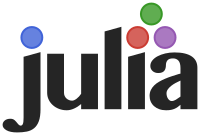With this blog, we are going to explore the Tensorflow.jl-Package for the Julia Programming Language.
I am new to both Tensorflow and Julia - so please don’t expect any in-depth programming tricks or advanced API explanations. I will use Google’s newly released Machine Learning Crash Course and implement most of the exercises in a Jupyter notebook.
Why Julia?

Julia is a rather new programming language, initially released in 2012. The things that attracted me personally are
- Most of my professional life, I have developed code in Matlab. Julia’s syntax is very close to that of Matlab, which makes the transition very easy.
- Julia is open-source. So no hassles with obtaining an expensive license.
- Julia is fast (as compared to Matlab or Python). Its just-in-time compiler compiles the code to native machine code before execution. One of the first bits of code I wrote with Julia contained a part that enlarged and appended a big array for thousands of iterations. Of course this is very bad programming practise - but still it performed surprisingly well.
Why TensorFlow?

- TensorFlow is open-source and used by Google and many other big companies for production machine learning tasks.
Disclaimer
I am neither affiliated with Google (who runs the Machine Learning Crash Course), Julia or the creators of Tensorflow.jl. This is a pure just-for-fun hobby project.